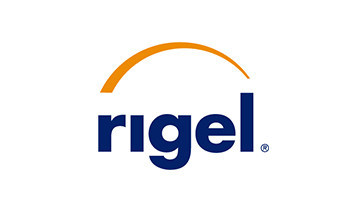Rigel Announces Publication of REZLIDHIA™ (olutasidenib) Phase 2 Clinical Results in Blood Advances
Rigel Pharmaceuticals (NASDAQ: RIGL) announced positive results from its Phase 2 study of REZLIDHIA (olutasidenib) for treating mutant isocitrate dehydrogenase 1 (mIDH1) relapsed or refractory acute myeloid leukemia (R/R AML). The study, published in Blood Advances, included 153 adult patients, revealing a 35% complete remission plus complete remission with partial hematologic recovery (CR+CRh) rate. Notably, patients achieving CR+CRh had a median overall survival (OS) not yet reached, with 78% survival at 18 months. REZLIDHIA shows promise as a differentiated therapy, particularly following its recent FDA approval.
- 35% CR+CRh rate in mIDH1 R/R AML patients with REZLIDHIA.
- Median OS not reached in CR+CRh patients, with an estimated 18-month survival rate of 78%.
- Median duration of CR+CRh was 25.9 months and CR was 28.1 months.
- REZLIDHIA received FDA approval on December 1, 2022, and is now commercially available.
- Differentiation syndrome occurred in 14% of patients, with potential for severe complications.
- Hepatotoxicity reported in 23% of patients, with 13% experiencing severe cases.
Insights
Analyzing...
˗ REZLIDHIA induced durable remissions in adult patients with mIDH1 R/R AML
The pivotal cohort of the Phase 2 registrational study enrolled 153 adult patients with mIDH1 R/R AML who received REZLIDHIA monotherapy 150 mg twice daily orally. The efficacy evaluable population included 147 patients with centrally confirmed mIDH1. The primary endpoint was a composite of complete remission (CR) plus complete remission with partial hematologic recovery (CRh). CRh is defined as less than
Key findings from the trial are summarized below:
- REZLIDHIA demonstrated a
35% (51/147) CR+CRh rate in mIDH1 R/R AML patients. Of the patients who achieved the primary endpoint of CR+CRh,92% (47/51) were CR. Most patients who achieved CR or CRh responded early, with a median time to response of 1.9 months. The overall response rate was48% (71/147). Response rates were similar in patients who had and who had not received prior venetoclax. - In patients treated with REZLIDHIA, the median duration of CR+CRh was 25.9 months and the median duration of CR was 28.1 months. The median duration of overall response was 11.7 months.
- Median overall survival (OS) was 11.6 months in the overall population of 153 patients. In patients who achieved CR+CRh, median OS was not reached and the estimated 18-month survival was
78% . - Conversion to transfusion independence (TI), another recognized indicator of clinical benefit, was achieved in
34% of patients receiving REZLIDHIA that had been classified as dependent on RBC and/or platelet transfusions at baseline. TI was observed in patients in all response groups. - REZLIDHIA was well characterized with an adverse event profile largely representative of symptoms or conditions experienced by patients with AML undergoing treatment. Investigators observed differentiation syndrome in
14% of patients that was manageable in most cases with dose interruption and corticosteroids. The most common adverse events were gastrointestinal and hematologic in nature, and most cases were manageable with dose interruptions or modifications.
The paper, titled "Olutasidenib (FT-2102) induces durable complete remissions in patients with relapsed or refractory IDH1-mutated AML," was published online in Blood Advances on
"REZLIDHIA demonstrated both a high rate of response and an extended median duration of complete response of 28.1 months, which is more than a year longer than what is reported with the standard of care," said
"The published data adds to our robust body of evidence reinforcing REZLIDHIA as a differentiated and potentially market-leading therapy for mIDH1 R/R AML patients," said
On
On
About AML
Acute myeloid leukemia (AML) is a rapidly progressing cancer of the blood and bone marrow that affects myeloid cells, which normally develop into various types of mature blood cells. AML occurs primarily in adults and accounts for about 1 percent of all adult cancers. The
Relapsed AML affects about half of all patients who, following treatment and remission, experience a return of leukemia cells in the bone marrow.3 Refractory AML, which affects between 10 and 40 percent of newly diagnosed patients, occurs when a patient fails to achieve remission even after intensive treatment.4 Quality of life declines for patients with each successive line of treatment for AML, and well-tolerated treatments in relapsed or refractory disease remain an unmet need.
About REZLIDHIA™
INDICATION
REZLIDHIA is indicated for the treatment of adult patients with relapsed or refractory acute myeloid leukemia (AML) with a susceptible isocitrate dehydrogenase-1 (IDH1) mutation as detected by an FDA-approved test.
IMPORTANT SAFETY INFORMATION
WARNING: DIFFERENTIATION SYNDROME |
Differentiation syndrome, which can be fatal, can occur with REZLIDHIA treatment. Symptoms may include dyspnea, pulmonary infiltrates/pleuropericardial effusion, kidney injury, hypotension, fever, and weight gain. If differentiation syndrome is suspected, withhold REZLIDHIA and initiate treatment with corticosteroids and hemodynamic monitoring until symptom resolution. |
WARNINGS AND PRECAUTIONS
Differentiation Syndrome
REZLIDHIA can cause differentiation syndrome. In the clinical trial of REZLIDHIA in patients with relapsed or refractory AML, differentiation syndrome occurred in
If differentiation syndrome is suspected, temporarily withhold REZLIDHIA and initiate systemic corticosteroids (e.g., dexamethasone 10 mg IV every 12 hours) for a minimum of 3 days and until resolution of signs and symptoms. If concomitant leukocytosis is observed, initiate treatment with hydroxyurea, as clinically indicated. Taper corticosteroids and hydroxyurea after resolution of symptoms. Differentiation syndrome may recur with premature discontinuation of corticosteroids and/or hydroxyurea treatment. Institute supportive measures and hemodynamic monitoring until improvement; withhold dose of REZLIDHIA and consider dose reduction based on recurrence.
Hepatotoxicity
REZLIDHIA can cause hepatotoxicity, presenting as increased alanine aminotransferase (ALT), increased aspartate aminotransferase (AST), increased blood alkaline phosphatase, and/or elevated bilirubin. Of 153 patients with relapsed or refractory AML who received REZLIDHIA, hepatotoxicity occurred in
Monitor patients frequently for clinical symptoms of hepatic dysfunction such as fatigue, anorexia, right upper abdominal discomfort, dark urine, or jaundice. Obtain baseline liver function tests prior to initiation of REZLIDHIA, at least once weekly for the first two months, once every other week for the third month, once in the fourth month, and once every other month for the duration of therapy. If hepatic dysfunction occurs, withhold, reduce, or permanently discontinue REZLIDHIA based on recurrence/severity.
ADVERSE REACTIONS
The most common (≥
DRUG INTERACTIONS
- Avoid concomitant use of REZLIDHIA with strong or moderate CYP3A inducers.
- Avoid concomitant use of REZLIDHIA with sensitive CYP3A substrates unless otherwise instructed in the substrates prescribing information. If concomitant use is unavoidable, monitor patients for loss of therapeutic effect of these drugs.
LACTATION
Advise women not to breastfeed during treatment with REZLIDHIA and for 2 weeks after the last dose.
GERIATRIC USE
No overall differences in effectiveness were observed between patients 65 years and older and younger patients. Compared to patients younger than 65 years of age, an increase in incidence of hepatotoxicity and hypertension was observed in patients ≥65 years of age.
HEPATIC IMPAIRMENT
In patients with mild or moderate hepatic impairment, closely monitor for increased probability of differentiation syndrome.
Click here for Full Prescribing Information, including Boxed WARNING.
To report side effects of prescription drugs to the FDA, visit www.fda.gov/medwatch or call 1-800-FDA-1088 (800-332-1088).
REZLIDHIA is a trademark of
About Rigel
- de Botton S, et al. Olutasidenib (FT-2102) induces durable complete remissions in patients with relapsed or refractory IDH1-mutated AML. Blood Advances.
February 1, 2023 .
doi: https://doi.org/10.1182/bloodadvances.2022009411 - The
American Cancer Society . Key Statistics for Acute Myeloid Leukemia (AML). RevisedJanuary 12, 2022 . AccessedAug. 1, 2022 at https://www.cancer.org/cancer/acute-myeloid-leukemia/about/key-statistics.html - Leukaemia Care. (2019). Relapse in Acute Myeloid Leukaemia (AML). Version 3. Reviewed
October 2021 . AccessedDec 2, 2021 at https://media.leukaemiacare.org.uk/wp-content/uploads/Relapse-in-Acute-Myeloid-Leukaemia-AML-Web-Version.pdf - Thol F, Schlenk RF, Heuser M,
Ganser A. How I treat refractory and early relapsed acute myeloid leukemia. Blood (2015) 126 (3): 319-27. doi: https://doi.org/10.1182/blood-2014-10-551911
Rigel Forward Looking Statements
This press release contains forward-looking statements relating to, among other things, that olutasidenib may provide a meaningful benefit to people with relapsed or refractory acute myeloid leukemia, our ability to commercialize olutasidenib in the
Rigel Contacts
Media:
Phone: 212.600.1902
Email: david.rosen@argotpartners.com
Investors:
Phone: 650.624.1232
Email: ir@rigel.com
![]() View original content to download multimedia:https://www.prnewswire.com/news-releases/rigel-announces-publication-of-rezlidhia-olutasidenib-phase-2-clinical-results-in-blood-advances-301737877.html
View original content to download multimedia:https://www.prnewswire.com/news-releases/rigel-announces-publication-of-rezlidhia-olutasidenib-phase-2-clinical-results-in-blood-advances-301737877.html
SOURCE








